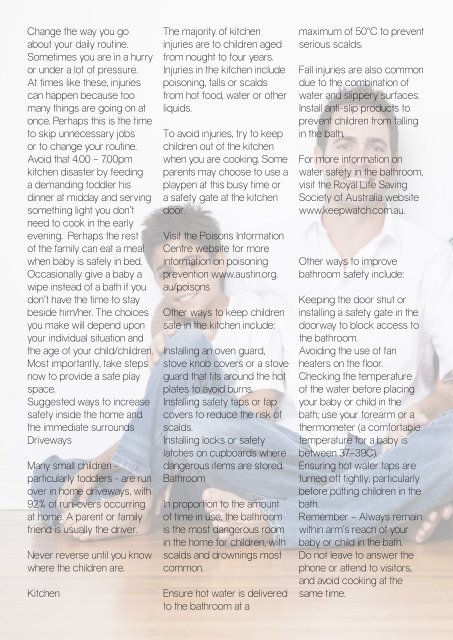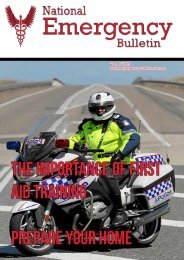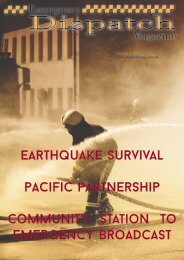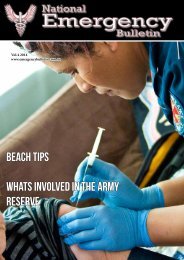Safe Kids Watch Vol 8 2015
Create successful ePaper yourself
Turn your PDF publications into a flip-book with our unique Google optimized e-Paper software.
Change the way you go<br />
about your daily routine.<br />
Sometimes you are in a hurry<br />
or under a lot of pressure.<br />
At times like these, injuries<br />
can happen because too<br />
many things are going on at<br />
once. Perhaps this is the time<br />
to skip unnecessary jobs<br />
or to change your routine.<br />
Avoid that 4.00 – 7.00pm<br />
kitchen disaster by feeding<br />
a demanding toddler his<br />
dinner at midday and serving<br />
something light you don’t<br />
need to cook in the early<br />
evening. Perhaps the rest<br />
of the family can eat a meal<br />
when baby is safely in bed.<br />
Occasionally give a baby a<br />
wipe instead of a bath if you<br />
don’t have the time to stay<br />
beside him/her. The choices<br />
you make will depend upon<br />
your individual situation and<br />
the age of your child/children.<br />
Most importantly, take steps<br />
now to provide a safe play<br />
space.<br />
Suggested ways to increase<br />
safety inside the home and<br />
the immediate surrounds<br />
Driveways<br />
Many small children -<br />
particularly toddlers - are run<br />
over in home driveways, with<br />
92% of run-overs occurring<br />
at home. A parent or family<br />
friend is usually the driver.<br />
Never reverse until you know<br />
where the children are.<br />
Kitchen<br />
The majority of kitchen<br />
injuries are to children aged<br />
from nought to four years.<br />
Injuries in the kitchen include<br />
poisoning, falls or scalds<br />
from hot food, water or other<br />
liquids.<br />
To avoid injuries, try to keep<br />
children out of the kitchen<br />
when you are cooking. Some<br />
parents may choose to use a<br />
playpen at this busy time or<br />
a safety gate at the kitchen<br />
door.<br />
Visit the Poisons Information<br />
Centre website for more<br />
information on poisoning<br />
prevention www.austin.org.<br />
au/poisons<br />
Other ways to keep children<br />
safe in the kitchen include:<br />
Installing an oven guard,<br />
stove knob covers or a stove<br />
guard that fits around the hot<br />
plates to avoid burns.<br />
Installing safety taps or tap<br />
covers to reduce the risk of<br />
scalds.<br />
Installing locks or safety<br />
latches on cupboards where<br />
dangerous items are stored.<br />
Bathroom<br />
In proportion to the amount<br />
of time in use, the bathroom<br />
is the most dangerous room<br />
in the home for children, with<br />
scalds and drownings most<br />
common.<br />
Ensure hot water is delivered<br />
to the bathroom at a<br />
maximum of 50°C to prevent<br />
serious scalds.<br />
Fall injuries are also common<br />
due to the combination of<br />
water and slippery surfaces.<br />
Install anti-slip products to<br />
prevent children from falling<br />
in the bath.<br />
For more information on<br />
water safety in the bathroom,<br />
visit the Royal Life Saving<br />
Society of Australia website<br />
www.keepwatch.com.au.<br />
Other ways to improve<br />
bathroom safety include:<br />
Keeping the door shut or<br />
installing a safety gate in the<br />
doorway to block access to<br />
the bathroom.<br />
Avoiding the use of fan<br />
heaters on the floor.<br />
Checking the temperature<br />
of the water before placing<br />
your baby or child in the<br />
bath; use your forearm or a<br />
thermometer (a comfortable<br />
temperature for a baby is<br />
between 37–39C).<br />
Ensuring hot water taps are<br />
turned off tightly, particularly<br />
before putting children in the<br />
bath.<br />
Remember – Always remain<br />
within arm’s reach of your<br />
baby or child in the bath.<br />
Do not leave to answer the<br />
phone or attend to visitors,<br />
and avoid cooking at the<br />
same time.





